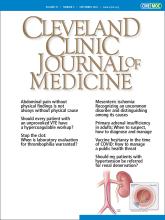Article Figures & Data
Tables
Category and cause Key featuresa Congenital adrenal hyperplasia1 21-Hydroxylase deficiency Most common subtype
Classic variant causes deficiency of both cortisol and aldosterone
Can also cause virilization in females due to accumulation of dehydroepiandrosterone metabolites11-Beta-hydroxylase deficiency Accumulation of aldosterone precursor 11-deoxycorticosterone results in hypertension and hypokalemia 3-Beta-hydroxylase deficiency Lack of dehydroepiandrosterone conversion to testosterone causes ambiguous genitalia in boys Other enzymatic abnormality17 Aldosterone synthase deficiency Isolated mineralocorticoid deficiency Deficiency of P450 side-chain cleavage enzyme Slows the rate-limiting step in cortisol synthesis ACTH resistance23 Familial glucocorticoid deficiency type 1 Tall stature, isolated deficiency of glucocorticoids, and generally normal aldosterone production 3A (Allgrove, AAA) syndrome Achalasia, Addison disease, alacrimia, AAAS gene mutation Adrenoleuko dystrophy23 Accumulation of very long chain fatty acid in adrenal cortex Inhibited response to ACTH; X-linked recessive disorder associated with neurologic deficits that predominantly affects males and typically presents in adolescence Congenital adrenal dysgenesis1 Congenital but can also be secondary to ACTH deficiency Hypotrophy of adrenal cortex, adrenal insufficiency, hypogonadism, especially in males due to reduction in adrenal androgens Others (rare)1,17,23 Wolman disease Lysosomal acid lipase deficiency that results in accumulation of fat and diffuse punctate adrenal calcification causing adrenal insufficiency
Very poor prognosisAbetalipoproteinemia Fat malabsorption results in lack of cholesterol to make steroids Mitochondrial disorders External ophthalmoplegia, retinal degeneration, cardiac conduction defects ↵aNot all listed primary adrenal conditions necessarily present with both glucocorticoid and mineralocorticoid deficiency.
AAA = achalasia, Addison disease, alacrimia; ACTH = adrenocorticotropic hormone
Category and cause Key featuresa Autoimmune (most common) Sporadic (from affected 21-hydroxylase enzyme) 40% of autoimmune cases,12 common in patients age 30–5025 Autoimmune polyglandular syndrome type 1b Hypoparathyroidism, chronic mucocutaneous candidiasis, Addison disease, other autoimmune diseases such as pernicious anemia, alopecia (5% to 10%)17 Autoimmune polyglandular syndrome type 2b Autoimmune thyroid disease, type 1 diabetes, vitiligo, premature gonadal failure (60%)17 Infection Tuberculosis Most common cause in countries where tuberculosis is prevalent
An extra-adrenal primary lesion is usually present
Antitubercular medications do not reverse destruction18Disseminated histoplasmosis, paracoccidioidomycosis, human immunodeficiency virus or acquired immunodeficiency syndrome, cytomegalovirus, tertiary syphilis Extremely rare, extra-adrenal manifestations are seen first Injury Bilateral adrenal hemorrhage due to sepsis Classically with disseminated meningococcemia, but can also occur with Pseudomonas aeruginosa, Streptococcus pneumoniae, or Staphylococcus aureus sepsis19 Bilateral adrenal hemorrhage due to anticoagulation Rarely occurs with systemic anticoagulation
Usually within the first 2 weeks of therapy20Infarction due to antiphospholipid antibody syndrome Bilateral venous thrombosis
Affects more men than women
Antibodies target lipid-rich cells in the adrenal gland21Physical trauma Metastases In decreasing order: lung, breast, melanoma, stomach22 Adrenal glands are prone to metastasis due to relatively rich blood supply
Mere presence of metastasis does not cause adrenal insufficiency; severe destruction (> 90%) of the adrenal cortex is necessaryAcquired adrenal dysgenesis Secondary to adrenocorticotropic hormone deficiency; can also be congenital Hypotrophy of adrenal cortex, adrenal insufficiency, hypogonadism, especially in males due to reduction in adrenal androgens1 Iatrogenic Surgical bilateral adrenalectomy Usually performed in the setting of Cushing disease or bilateral pheochromocytoma Drugs See Table 3 Infiltrative Hemochromatosis, sarcoidosis, amyloidosis Extensive infiltration of adrenal cortex results in dense fibrosis and deficiency of cortisol and aldosterone24 Druga Use Mechanism of primary adrenal insufficiency Mitotane Adrenolytic adrenocortical carcinoma therapy Damages adrenal cortex through free radical generation, blocks cortisol production, and alters peripheral conversion of steroids27 Etomidate Anesthetic Etomidate and metyrapone inhibit 11-beta-hydroxylase and decrease endogenous cortisol synthesis28,29
Mifepristone in high doses blocks the glucocorticoid receptor28Metyrapone, mifepristone Cushing syndrome therapy Ketoconazole Antifungal Inhibits several adrenal enzymes responsible for androgen and cortisol synthesis such as cholesterol side chain cleavage enzyme, 17-alpha-hydroxylase, 11-beta-hydroxylase, and aldosterone synthase28 Levoketoconazole Cushing syndrome therapy Rifampicin Antitubercular Induce CYP3A4, promote rapid cortisol clearance from the blood17 Phenytoin Antiseizure Immune checkpoint inhibitors: ipilimumab (CTLA-4), nivolumab (PD-1), pembrolizumab (PD-1) Malignancy therapy, most often melanoma Can cause adrenal antibodies, resulting in destruction of cortex30,31
Can also be associated with secondary adrenal insufficiency through hypophysitisAbiraterone Prostate cancer therapy Selectively and irreversibly inhibits 17-alpha-hydroxylase/C17,20-lyase to cause androgen and glucocorticoid deficiency32 ↵aNot all listed medications causing primary adrenal insufficiency necessarily present with both glucocorticoid and mineralocorticoid deficiency.
PD-1 = programmed cell death protein 1; CTLA-4 = cytotoxic T-lymphocyte–associated protein 4.
Based on information from references 1,17,23,27–32.






